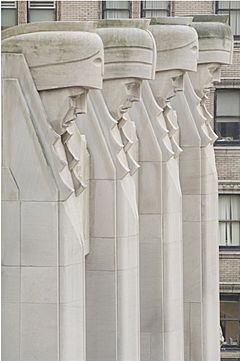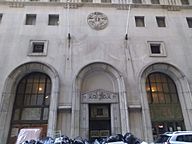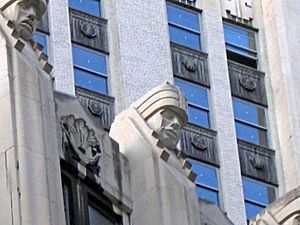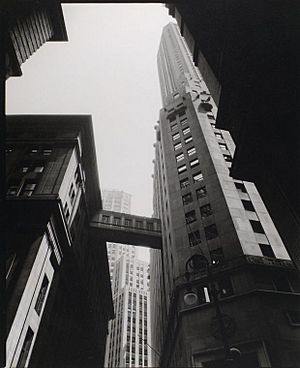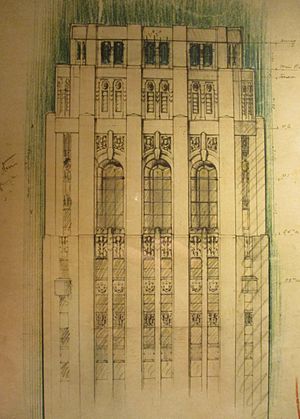20 Exchange Place facts for kids
Quick facts for kids 20 Exchange Place |
|
|---|---|
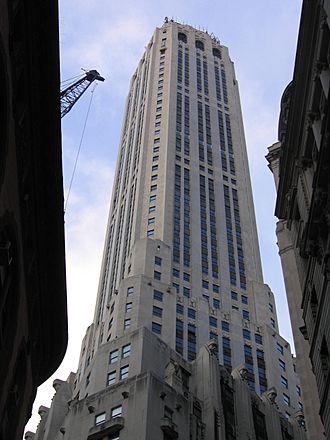 |
|
| General information | |
| Location | Manhattan, New York |
| Coordinates | 40°42′20″N 74°0′35″W / 40.70556°N 74.00972°W |
| Construction started | 1930 |
| Completed | 1931 |
| Opening | February 24, 1931 |
| Height | |
| Antenna spire | 741 ft (226 m) |
| Technical details | |
| Floor count | 57 |
| Floor area | 730,234 sq ft (67,841.0 m2) |
| Design and construction | |
| Architect | Cross and Cross |
| Main contractor | George A. Fuller Company |
| References | |
|
New York City Landmark
|
|
| Designated: | June 25, 1996 |
| Reference #: | 1941 |
20 Exchange Place (formerly the City Bank–Farmers Trust Building) is a skyscraper in the Financial District of Lower Manhattan in New York City. Completed in 1931, it was designed by Cross & Cross in the Art Deco style as the headquarters of the City Bank–Farmers Trust Company, predecessor of Citigroup. The building, standing at approximately 741 feet (226 m) with 57 usable stories, was one of the city's tallest buildings and the world's tallest stone-clad building at the time of its completion. While 20 Exchange Place was intended to be the world's tallest building at the time of its construction, the Great Depression resulted in the current scaled-back plan.
The building has a granite and limestone facade, as well as internal superstructure is made of steel. The lower section of the facade fills an entire irregular city block, and contains giant piers supporting standalone figures depicting the "giants of finance", as well as decorations designed by David Evans. The main entrance on Exchange Place has a round arch with granite medallions representing the countries where City Bank Farmers Trust operated offices. The upper stories rise as a square tower with chamfered corners and is offset from the base.
The City Bank–Farmers Trust Building was built between 1930 and 1931, for the newly merged National City Bank of New York and the Farmers' Loan and Trust Company. It remained the company's headquarters until 1956 and was ultimately sold in 1979. The 16th through 57th floors of the building were converted from commercial to residential space by Metro Loft Management during the 1990s. The New York City Landmarks Preservation Commission designated 20 Exchange Place as an official city landmark in 1996. It is also a contributing property to the Wall Street Historic District, a National Register of Historic Places district created in 2007.
Contents
Site
20 Exchange Place occupies a full block along Exchange Place to the north, Hanover Street to the east, Beaver Street to the south, and William Street to the west. The surrounding street grid, built as part of the colony of New Amsterdam, remains mostly as documented in the 17th-century Castello Plan. As such, the block is irregular in shape. Nearby buildings include 55 Wall Street to the north; the Wall and Hanover Building to the northeast; the 1 Wall Street Court to the east; the Delmonico's Building and 1 William Street to the southwest; and the 15 William and Broad Exchange Building to the west.
The first recorded structure on the site was the house of Dutch ship's carpenter Tymen Jansen, built in the 17th century. By the 1890s, the block was occupied by larger buildings. Just prior to 20 Exchange Place's construction, the block contained four structures: two 10-story buildings on William Street, one 9-story building on Hanover Street, and one 15-story building extending between Beaver Street and Exchange Place.
Design
The City Bank–Farmers Trust Building was designed by Cross and Cross and constructed by the George A. Fuller Company, with Moran & Proctor as the engineers for the foundation and tower. The firm described the building as having no particular architectural style. However, observers characterized it as having a "modern classic" style with minimal Art Deco ornamentation.
The precise height of 20 Exchange Place is disputed. According to Emporis and SkyscraperPage, the building is 741 feet (226 m) tall with 57 usable stories, and has an antenna reaching 748 feet (228 m). However, the New York City Landmarks Preservation Commission quotes New York City Department of Buildings records as saying that the building is only 685 feet 7.125 inches (209 m) tall. Christopher Gray of The New York Times described the building as being 59 stories high and 750 feet (230 m) in 2008. Another Times article and the Wall Street Journal, in 1931, quoted the building as being 745 feet (227 m) tall (accounting for minor deviations), but having only 54 usable stories, excluding the spaces at the top.
The base of the building fills the entire block. There are several setbacks between the base and tower portions of 20 Exchange Place, including at the 19th and 21st floors. The tower portion, rising above the 21st floor, is eight-sided in plan, with four chamfered corners between four longer sides.
Facade
The facade was made almost entirely of white Rockwood stone, except the first floor, which is clad with Mohegan granite. Some 180,000 cubic feet (5,100 m3) of gray- and blue-tinted stone was quarried from Alabama and brought to New York in pieces weighing up to 49,500 pounds (22,500 kg). The stone weighed 27,000,000 pounds (12,000,000 kg) in total.
Entrances
The main entrance, on the Exchange Place elevation, has a round arch surrounded by eleven granite medallions representing the countries where City Bank Farmers Trust operated offices. There are also granite medallions flanking and above the arch, as well as the National City Bank's seal at the top left and the National City Company's seal at the top right. Two vertical illuminated signs, one on either side of the arch, contain the word "Twenty". Within this arch, there are steps leading to doors underneath a large grouping of windows, while a lamp hangs from a soffit at the top of the arch's ceiling.
Another entrance faces the corner of Exchange Place and William Street. It has four doors made of silver and an alloy of bronze, zinc, and copper, and are trimmed with bronze. The doors each contain three panels showing different modes of transportation. Above the outer doors are nickel silver panels with allegorical bronze figures, one symbolizing banking and the other symbolizing abundance; both are surrounded by animal and floral figures. There are glass panes above the doors and panels; they are separated by mullions ornamented with industry symbols. A seal of City Bank Farmers Trust and a flagpole are mounted above the entrance. This led to City Bank Farmers Trust's main banking space.
A third entrance, at Beaver and William Streets, is similar to the Exchange Place and William Street entrance, except that it only has two paneled doors. The doors and the panels above the doors are surrounded by a granite frame. The glass panes above the granite frame do not have ornamented mullions.
A fourth entrance faces Beaver Street and consists of three round arches with carved surroundings. The center arch is a service entrance and has another carved surround with a small pediment above the door, consisting of snakes flanking a bison head above the door. The side arches each have four nickel-silver doors underneath marble-and-glass transoms. There is also a medallion above the center arch.
A fifth entrance is centered on the Hanover Street elevation, and is an arched opening with a carved surround. Similar to the entrance at Exchange Place and William Street, there are four paneled doors, as well as nickel silver panels above the doors, and a set of glass panes above the doors and panels separated by ornamental mullions. When the building opened, the Canadian Bank of Commerce used a banking space accessible from this entrance.
Other elements
On the William Street, Beaver Street, and Exchange Place elevations, the lowest two stories of the base have several double-height window openings, all of which contain a silver grille at the bottom and keystones above the top center. There are smaller square-headed windows at the extreme ends of all of the building's elevations, including the Hanover Street side. On William Street, the only side that does not have a direct entrance, there are five large window openings. The Beaver Street elevation has seven large windows: three to the west of the entrance and four to the east. The Exchange Place elevation has three large windows east of the center archway and one large window to the west, as well as an additional two small windows on either side of the arch. The Hanover Place entrance is flanked by the smaller windows.
The rest of the base contains relatively little decoration, with sash windows on each floor. The 4th floor contains small rectangular openings, and the 5th floor contains single windows or pairs of windows separated by geometric panels, and topped by a boxy cornice with geometric shapes. Between the 6th and 17th stories, the spandrels between the windows on each floor are made of either blue-pearl granite or aluminum, and many spandrels have medallions. Piers subdivide the windows into either singular or paired groupings. On the tops of the piers that are directly in front of the tower, there are fourteen figures at the 19th floor, representing "giants of finance"; half are depicted with scowls, while the other half have smiles. The intake pipes for the building's heating, ventilation, and air conditioning system are concealed behind the spandrels, while the exhaust pipes are behind the "giants of finance". The outermost piers are topped by eagles at the 17th floor.
The upper floors contain sparse decoration as well. Between the sash windows on each floor are aluminum spandrels, many of which also contain medallions. These windows are grouped into three pairs per side. The corners of the tower are chamfered, with one window on each floor. At the 29th, 39th, 48th, and 55th stories, there are ashlar bands between each floor, instead of aluminum spandrels. The 55th through 57th stories contain three tall arches on each side. The arches are underneath the two-tiered "crown", which has communications equipment.
Features
The underlying ground contained quicksand and water, as well as foundations from the previous buildings on the site, and the entire city block was irregularly shaped. As a result, the building used cross-lot bracing as well as a heavy steel frame. The building included four basement levels, descending 65 feet (20 m) below the curb. The two lowest basement floors were dug out of the bedrock 40 feet (12 m) below the groundwater level. The superstructure used 20,200 short tons (18,000 long tons; 18,300 t) of steel.
The building was constructed with four elevator banks, containing a total of 31 elevators. The banking floors also had what was described as the world's largest pneumatic-tube system to be used in a banking facility. The two buildings comprising National City Bank's global headquarters, 20 Exchange Place and 55 Wall Street, were connected by a now-demolished pedestrian bridge over Exchange Place, located at the ninth floor.
Lower stories
The main entrance on Exchange Place leads to a rotunda with numerous types of marble, including a Czechoslovak golden travertine. The rotunda measures 30 feet (9.1 m) high by 36 feet (11 m) across, finished in stone and carried by six red marble columns. The lobbies contained 45 types of marble from numerous countries, including at least six European countries; only two types of marble were from the United States. The rotunda's design might have been inspired by French architect Roger-Henri Expert's work. The dome consists of stepped concentric rings with black and silver stenciling, with a plastic hemisphere at the apex of the dome.
A half-flight of stairs leads upward from the rotunda to a space that formerly contained the senior officers' room. The space measures 48 by 85 feet (15 by 26 m), with large pillars and English oak paneling. The offices of City Bank's president were at the back of the senior officers' room. Another half-flight of stairs, leading down from the rotunda, connected to the branch banking rooms, whose main entrance was at William and Beaver Streets. The high ceilings were used as a filming location for several movies such as Inside Man and The Amazing Spider-Man 2.
There were five banking rooms used by the City Bank Farmers Trust Company. Besides the branch banking room, there was a securities room at ground level, a transfer room and another securities room in basement level A, and a reserve banking room in basement level B. The basements contained two large vaults each measuring 156 by 52 feet (48 by 16 m), as well as a smaller vault for overnight storage; the vaults were guarded by doors weighing between 30 to 40 short tons (27 to 36 t). The security system could detect tiny vibrations in the steel and concrete. The basement also had a three-man shooting gallery for the vault's guards to practice.
Upper stories
The fifteenth floor was devoted exclusively to a telephone exchange, where 37 switchboard operators worked at an exchange that connected with 600 trunk lines and 3,600 extensions. Telephone engineers considered the exchange to be the world's largest. There were dining rooms and kitchens on the 51st and 52nd floors. Since being converted to residential use, 20 Exchange Place has contained 767 residential apartments. There are also several residential amenities such as a gym, lounge, and gaming room.
The upper floors were decorated with 15 types of wood. A copper and nickel alloy was used for other ornamental features; the baseboards used stainless steel; and the handrails and toilets were plated with chromium. The floors in the 27 upper stories average 5,000 square feet (460 m2). The top floors taper to 2,000 square feet (190 m2).
History
National City Bank and the Farmers' Loan and Trust Company were both longstanding New York City institutions, with the former being founded in 1812 and the latter in 1822. In subsequent years, other banks began moving to residential buildings on Wall Street, and by the 1820s, financial institutions made up the vast majority of tenants there. By the late 19th century, the site of 20 Exchange Place had become associated with the banking industry as well, with institutions such as the Canadian Bank of Commerce occupying the buildings on the block. In 1908, National City Bank moved its headquarters to 55 Wall Street, on the block directly to the north. The Farmers Loan and Trust Company, meanwhile, occupied one of the buildings on 20 Exchange Place's site. National City Bank and the Farmers' Loan and Trust Company merged in 1929. National City Bank took over the expanded bank's banking operations, while Farmers' Trust became the City Bank Farmers Trust Company, a subsidiary of National City Bank that took over the trust operations.
Construction
After the merger, City Bank Farmers Trust commissioned a new structure at 20 Exchange Place to house the operations of the expanded bank. At the time, several skyscrapers in New York City were competing to be the world's tallest building, including the Chrysler Building, the Empire State Building, and 40 Wall Street, none of which were yet under construction. 20 Exchange Place was originally among those contenders for that title. In October 1929, City Bank Farmers Trust filed tentative plans for a structure of either 846.4 or 925 feet (258.0 or 281.9 m), with 71 stories and a budget of $9.5 million. This building would have consisted of an 80-by-80-foot (24 by 24 m) rising above the 28th floor and tapering at the 50th floor, with a 15-foot (4.6 m) globe-shaped lantern at the pinnacle supported by four eagles. The skyscraper as initially planned would have been the headquarters for a larger bank created by merging the City Bank Farmers Trust and the Corn Exchange Bank. At least three early architect's sketches were drawn. The merger between the City Bank Farmers Trust and the Corn Exchange Bank was scrapped in the Wall Street Crash of 1929, and the building was cut back to its current height.
Steel construction started in late February 1930, with the first steel column being placed on February 25. The Fuller Company, the building's contractor, employed an average of 2,000 workers simultaneously, with up to 3,000 workers on-site at a time; a large proportion of the workforce, comprising over 600 workers, were hired for the stonework. The builders anticipated a total payroll of $7.5 million with 5,000 total workers. The stonework was completed in November 1930. Some of the construction workers involved in the project were honored in a January 1931 ceremony. By February 20, 1931, the bank had started moving into its quarters.
Office use
The building opened for City Bank Farmers Trust's use on February 24, 1931. On opening day, The New York Times stated that about 3,851 people per hour visited the building. At the time, the upper floors were not open for use because the elevators had not been completed. When it opened, 20 Exchange Place the tallest stone-clad building in the world; that record would be surpassed by the Empire State Building, which opened on May 1, 1931.
Construction was officially completed in mid-March 1931, one and a half months ahead of schedule. The same month, National City Bank conveyed a one-fourth interest in the building to the City Bank Farmers Trust Company in March 1931. City Bank Farmers Trust occupied almost all of the space on the first through 12th floors, as well as the basement stories. The Canadian Bank of Commerce also took some space on the Hanover Street side of the ground level. Other tenants took space in the upper floors, including law firms, as well as other banks such as BNY Mellon and First Boston. City Bank Farmers Trust remained the largest occupant of the building, occupying 75% of the floor area at its peak. Part of the interior was altered in 1945.
National City Bank merged with the First National Bank in 1955, becoming First National City Bank. Shortly afterward, in March 1958, City Bank Farmers Trust took over the construction of a skyscraper on 399 Park Avenue, which was to contain most of the operations of First National City Bank. In 1961, City Bank Farmers Trust moved to the newly completed 399 Park Avenue in 1961. The same year, the eastern wing was undergoing renovations; in late 1961, some of these materials caught fire, leading 25 people to be trapped in the elevators. First National City Bank was renamed Citibank in 1976, and the bank sold off 20 Exchange Place in 1979, while retaining space there. According to telephone interviews conducted by the New York City Landmarks Preservation Commission, both Citibank and the Canadian Bank of Commerce moved out of 20 Exchange Place in 1989.
Residential use
In late 1997, the building was sold to a joint venture between the Witkoff Group and Kamran Hakim. Witkoff and Hakim considered plans to convert 20 Exchange Place into a hotel or a residential building, or retain office uses, before they ultimately decided to renovate the building for $25 million and convert the upper floors into apartments. Some 130,000 square feet (12,000 m2) in the lowest eighteen floors was retained as commercial space; a third of this area was taken by the Federal Deposit Insurance Corporation in 1999. During the renovation, some of the building's decorative elements were stolen. When DMJM Harris Arup took a 70,500-square-foot (6,550 m2) sublease at 20 Exchange Place in early 2002, it became one of the largest office leases in Lower Manhattan since the September 11, 2001, attacks.
By 2004, developers Yaron (Ronny) Bruckner and Nathan Berman had bought 20 Exchange Place. They proposed converting the building for nearly entirely residential use, with 250 condominiums in the tower and commercial space at the building's base. DTH Capital, a joint venture between the Bruckner family's Eastbridge Group and AG Real Estate, became the new developers of the building. The project received two mezzanine loans of a combined $135 million in 2004. Two years later, the joint venture received a $256.5 million construction loan from a group of several lenders; this loan was refinanced in 2009. These loans were used to convert some units to apartments. The first apartments were ready for occupancy by early 2008. Metro Loft Management, who oversaw the conversion, created 350 units between the 16th and 57th floors. In 2014, DTH Capital received an additional $240 million loan that allowed the firm to convert the 9th through 15th floors to 221 luxury units. DMJM Harris Arup had recently vacated the space at the time. The conversion was ultimately completed in 2015, spanning three phases of construction.
See also
 In Spanish: 20 Exchange Place para niños
In Spanish: 20 Exchange Place para niños


